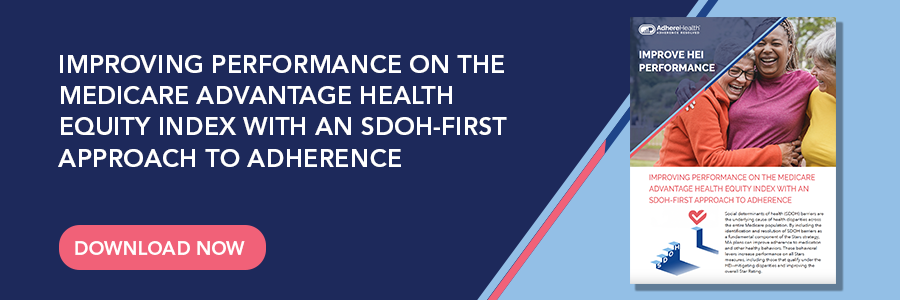Published on .
Health disparities are unfortunately common in the United States, affecting the quality and length of life for millions of people from traditionally underserved communities.
For example, people who identify as Black or American Indian/Alaskan Native have significantly lower life expectancies than those who identify as White, Hispanic or Asian. Plus, groups at greater health risk are more likely than others to bear the clinical and economic burdens of common chronic conditions, including diabetes and asthma.
The majority of health disparities are deeply rooted in centuries of the nation’s complicated socioeconomic and political history, but that doesn’t mean it’s impossible to acknowledge, address and adjust the future course of health equity for those experiencing significant barriers to care.
To help members surmount the social determinants of health (SDOH) barriers often standing in the way of positive health outcomes, health plans can leverage the support of outreach clinicians. These are the individuals within a plan member’s healthcare team (or extended services) in the perfect position to provide support and tools to overcome barriers for improved health. However, it’s critical for health plans to empower these clinicians with data and resources through access to the right healthcare analytics platform.
Championing health equity
The Centers for Medicare and Medicaid Services (CMS) has been at the forefront of the movement toward ensuring that every person has “a just and fair opportunity to attain their highest level of health,” stating in its 2022 strategic roadmap that “health equity will be embedded within the DNA of CMS and serve as the lens through which we view all our work.”
The new Health Equity Index (HEI) for certain eligible Medicare Advantage plans is one illustration that the agency is following through on its intentions. Plans will need to gather more detailed and accurate information about members’ socioeconomic challenges and take specific actions to close gaps in care. If they fail to perform well on behalf of their most vulnerable members, plans risk being shut out of valuable financial rewards. However, even plans that are not subject to the HEI have strong incentives to make health equity a priority.
The value of an SDOH-focused approach
By effectively resolving barriers to care for populations that struggle with higher burdens of chronic diseases and acute care needs, MA plans can improve patient experiences, reduce spending and boost health outcomes—all of which can result in higher quality of life for members, while fostering better plan performance on Star Ratings and enhanced opportunities for financial incentives (such as QBP).
The key to achieving these win/win results is identifying health disparities in specific populations and engaging these members in meaningful efforts to resolve their challenges.
To do so, plans need to invest in outreach efforts that drive effective, sustained engagement with a human touch. Experienced outreach clinicians should be at the core of these activities, and they must be empowered with the right technologies and resources to build empathetic relationships, actively resolve barriers to care and regularly follow up with members to ensure adherence to personalized care plans.
Building your Star Ratings strategy? Check out our white paper to take action on health equity!
Equipping outreach clinicians with the tools to enable health equity
Improving health outcomes for members experiencing health disparities requires a multi-faceted approach. Plans will need to adopt holistic strategies to address care gaps that have both clinical and non-clinical components, such as medication adherence.
Blending technology capabilities with a person-centered approach to authentic relationship-building is essential for outreach staff to maximize their value and assist plans in achieving Star Ratings goals.
Start with the right technology platform
Technology is at the core of a successful outreach program. Health plans need to automate and streamline the process of identifying high-priority outreach candidates and surface meaningful information to the outreach staff assigned to the case.
The right tools will augment and guide clinician interventions by suggesting the “next best action” to staff based on the documented needs of each individual member. For example, instead of leaving staff to “hunt and peck” through “chase lists” of members who may be due for a check-in, plans should adopt platforms that ingest new claims frequently, match those claims with publicly available socioeconomic vulnerability data to target members in need of intervention based on high-priority Stars measures, and automatically surface the next outreach call to clinicians.
This intelligent clinical workflow reduces the need for manual management of caseloads, making outreach staff more efficient and giving them more time to engage with members instead of conducting administrative tasks.
Make each touchpoint actionable and motivational
Health plan members experiencing socioeconomic challenges that lead to health disparities must be treated with respect, empathy and openness, especially if they are reluctant to speak about their issues or have a difficult time quantifying their concerns.
That’s where the experience and compassion of trained outreach staff brings value to each and every interaction. Outreach professionals should be encouraged to use proven strategies like motivational interviewing to create trust, uncover potential issues, and help members discover their own goals and strengths in the process.
Motivational interviewing should focus on identifying specific challenges, such as food insecurity or housing instability, that may lead members to make difficult choices about how and when to seek care or access their medications. Conversations should also touch upon the member’s personal health goals, such as feeling well enough to play with their grandchildren or attend a family event, and what is required to get them to that point in their health journey.
But the interaction must also go beyond simply identifying issues and objectives. To maintain trust and keep members engaged, outreach staff must also be equipped to offer actionable, effective solutions. Plans can provide these capabilities through a technology platform that surfaces details of the member’s plan benefits directly within the workflow. This way, staff can ensure the member is maximizing all available resources.
If members are experiencing additional barriers, the platform should also provide connections to external social programs (such as findhelp.org, 211.org or needymeds.org) that offer services to help members address a wide variety of socioeconomic concerns. Integrating access to resources like these into the workflow allows outreach staff to share options with members in real-time and maximize the likelihood of follow-up and resolution of the barrier.
Keep the conversation going with longitudinal tracking
Socioeconomic challenges are rarely static—and neither are Stars measures. Both often require multiple interventions, reviews and follow-ups as a member’s circumstances change. This helps ensure problems that get solved initially stay solved over time.
Longitudinal tracking is particularly important for certain triple-weighted measures related to medication adherence, which require members to have access to their medications for 80% of the year. A single check-in at the beginning of the year will likely not be adequate to ensure the member continues to remain adherent throughout the following months, so ongoing data monitoring and follow-up are essential for success.
Technology tools should continuously ingest data and keep track of member adherence to medications or healthy behaviors. They should also track clinical intervention notes so they’re available for the next outreach clinician to review while working with the member. This helps the plan avoid abrasion caused by repetitive questions, especially about sensitive topics, and offers certainty that the plan both understands the member’s unique concerns and views them as important.
In conclusion
Establishing and maintaining ongoing relationships between members and clinicians can be accomplished with the combination of person-centered interactions empowered by a robust technology platform. These key ingredients are crucial to support health plans in achieving the goal of health equity for members, while positioning plans advantageously for meeting the requirements of the HEI to earn additional Star Ratings rewards.
For more details about addressing and resolving SDOH barriers to achieve high performance on the HEI, check out our recent white paper: Improving Performance on the Medicare Advantage Health Equity Index with an SDOH-First Approach to Adherence.
To schedule a consultation, contact us today!
 Authored by:
Authored by:
Glenn Wirick
Office of the President, AdhereHealth

